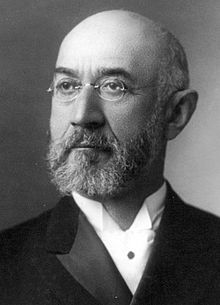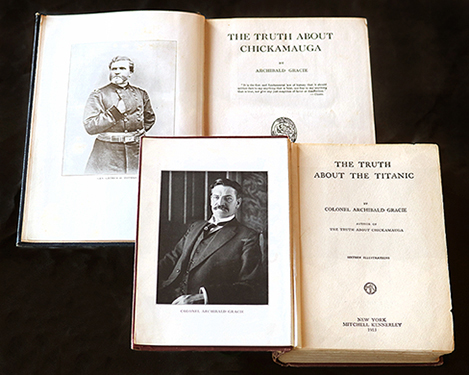Our Fearful Trip: Remembering the Civil War on RMS Titanic
James Cameron’s 1997 Hollywood blockbuster Titanic, like most historical movies, is fun to watch but doesn’t let the truth get in the way of a good story. Though we will never know for sure, the accents of two real-life passengers probably belong on the list of things the film got wrong. In one scene, Colonel Archibald Gracie, portrayed by Welsh actor Bernard Fox, gives off the air of a pompous British army officer as he dines with fictional lovers Jack and Rose. Later, as the ship is sinking, we hear fellow first-class passenger Isidor Straus speaking with a slight German or Yiddish accent, desperately trying to persuade his wife, Ida, to get into a lifeboat. (One of the film’s most memorable, if inaccurate, scenes shows the elderly couple lying on a bed quietly embracing as water fills their cabin.)
Moviegoers would have had a better sense of who Gracie and Straus really were if the film’s directors had cast actors from below the Mason-Dixon Line. Both passengers, it turns out, were Southerners with vivid memories of the Civil War.
Gracie, born in Mobile, Alabama, in 1859, came from a family of bankers and merchants. Though his family’s roots were in New York (their residence on the Upper East Side is now home to the city’s mayor), the Gracies made their fortune in the South, first in Virginia as tobacco exporters and later in the Cotton Kingdom. Related by marriage to "Old Fuss and Feathers," General Winfield Scott—a staunch Unionist despite his Virginia upbringing—Gracie's father nevertheless fought for the Confederacy as a brigadier general. He was killed in 1864 at the Siege of Petersburg.
The younger Gracie became a military man, too, with a passion for Civil War history. In 1911, he published a nearly 500-page book, The Truth about Chickamauga, a work that took him seven years to complete. Exhausted, Gracie traveled to Europe for a "much-needed rest." When it came time to return home, he booked passage on an elegant new liner named RMS Titanic.
As the supposedly unsinkable "floating palace" steamed out into the Atlantic, Gracie browsed its library, finding a copy of Mary Johnston’s Old Dominion, a romance set in colonial Virginia. "While peacefully reading the tales of adventure and accounts of extraordinary escapes therein," Gracie later recalled, "how little I thought that in the next few hours I should be a witness and a party to a scene to which this book could furnish no counterpart, and that my own preservation from a watery grave would afford a remarkable illustration of how ofttimes ‘the truth is stranger than fiction.'"
 Meanwhile, another passenger, Isidor Straus, was unwittingly spending the last hours of his life reading Gracie’s own book, The Truth about Chickamauga, loaned to him by the author. The millionaire co-owner of Macy’s department store in Manhattan shared the colonel’s interest in the Civil War and the two swapped anecdotes while lounging in the Titanic’s smoking room over the course of several days.
Meanwhile, another passenger, Isidor Straus, was unwittingly spending the last hours of his life reading Gracie’s own book, The Truth about Chickamauga, loaned to him by the author. The millionaire co-owner of Macy’s department store in Manhattan shared the colonel’s interest in the Civil War and the two swapped anecdotes while lounging in the Titanic’s smoking room over the course of several days.
Born in Germany, Straus had emigrated in 1854, at the age of nine, to rural Talbotton, Georgia, where his father Lazarus had already lived for several years working as an itinerant peddler and shopkeeper. At the outbreak of the Civil War, Isidor tried to enlist in the Confederate army but was turned down because of his age. Abandoning plans to enroll at the Georgia Military Academy, he started a delivery service and discovered he had a knack for making money. After the Strauses were accused of war profiteering along with other merchants, they picked up and moved from Talbotton, where they had been the only Jews in town, to nearby Columbus, a Confederate supply depot and home to a relatively large Jewish community.
Before long, Isidor was helping to raise money for the rebel cause. In 1863, he ran the Union blockade and shipped goods valued at more than two million dollars in today’s money from England back to Georgia. He also traveled to Cuba, where he oversaw the sale of stranded Southern ships. At war’s end, the Strauses left the South and reestablished themselves as china and glassware retailers in New York City. By the 1880s, Isidor and his brother Nathan were partners in Macy’s. They became full owners in 1896. Not forgetting his Georgia ties, however, Isidor did what he could to help struggling Southern businessmen get back on their feet. The South also remained a part of his family’s identity; one of Isidor’s nephews was even named after Robert E. Lee.
Straus and his wife both perished in the icy waters of the North Atlantic. Gracie himself only narrowly escaped, clinging to a rail of the giant ship until its stern plunged beneath the waves and then swimming through floating debris and bodies to a half-submerged canvas lifeboat. Little could he have known as he was putting the finishing touches on The Truth about Chickamauga that his next book, the one for which he is now remembered, would be The Truth about the Titanic. Published in 1913, it is one of the most important first-hand accounts of the disaster. Gracie never saw it in print. Already in failing health, the shock of his ordeal on the Titanic was thought to have caused his death in December 1912, eight months after the ship’s sinking.
Copies of The Truth about Chickamauga and The Truth about the Titanic were recently acquired for the Rare Book Collection in the LSU Libraries' Special Collections.
Did Gracie ever draw parallels between the Titanic and the Civil War? The analogy isn’t so far-fetched. Both were colossal examples of hubris and flawed planning. Deep social divides come to mind in both instances as well. Gracie could not have known the extent to which the Titanic legend would take on a life of its own, even though no less than four films, including one with a fictional love story, would appear within a year of the sinking. The increasingly sentimental and even touristic view of the Civil War, however, is certainly something he would have known about through countless factual works such as his own, as well as novels, poetry, and at least a dozen Civil War films that had already been produced by 1912 (three times that number had appeared before the decade was out). Though war and tragedy should never be turned into entertainment, it is hardly unique to our own time.
(This story was originally published in the Civil War Book Review, Fall 2015.)
Sources:
Gracie, Archibald. The Truth about the Titanic. New York: Mitchell Kennerley, 1913.
Gracie, Archibald. The Truth about Chickamauga. Boston: Houghton Mifflin Co., 1911.
McCash, June Hall. A Titanic Love Story: Ida and Isidor Straus. Macon: Mercer University Press, 2012.
Whitaker, Jan. “Isidor Straus.” In Immigrant Entrepreneurship: German-American Business Biographies, 1720 to the Present, vol. 2, edited by William J. Hausman. German Historical Institute. Last modified February 18, 2015. http://www.immigrantentrepreneurship.org/entry.php?rec=27.


